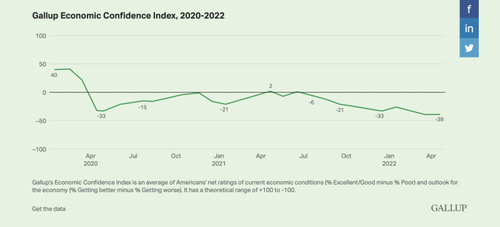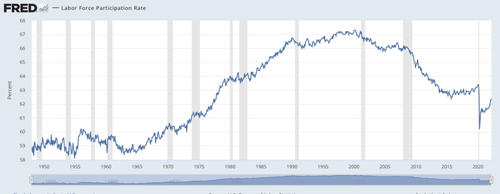Two Weeks To Flatten The GDP
Authored by Jeffrey Tucker via The Brownstone Institute,
What is it with these pundits and government spokespeople?
Two years ago, they were wildly exaggerating virus threats, canceling and censoring people who pointed out contrary evidence.
It was all about scaring people into compliance with a far-flung epidemiological experiment.
Now the tendency has swung the other way. No matter how bad the economic news is, the tendency is to downplay it, promise a turnaround soon, and otherwise claim that anyone who is worried is just being paranoid. We need only point to the claims from last fall that the inflation is merely “transitional.” Sure enough, it is easily the number one issue.
Last week it was the same. The GDP numbers reported a first-quarter shrinkage of 1.4% annualized and what do they tell us? This is just noise, not a signal. That was the main message from all media outlets.
It’s only a flesh wound, one might say. The economy will soon bounce back. Just give it time! Sure, but how much time? How deep can the recession/depression get? No one knows for sure. We know by now that the experts are happy to lie about their intuitions, if only to keep the public calm.
Truth is that based on the existing data, we are very deep into the formation of the real thing: an inflationary recession. It’s also called stagflation. Yes, that very thing that decades ago economists said would be impossible. It happened anyway in the 1970s. And it’s happening now. The only question that remains is just how bad this can get before it gets better.
To be sure, the GDP as a statistical measure of economic growth is a hot mess. When government spends money, it counts as growth. When businesses sustained by subsidies flop, it counts as shrinkage, even though the failure of unprofitable ventures frees up resources for better uses. Even trade deficits that count into the mix of GDP, such as exports are good and imports, are bad.
Still, it’s worth paying attention because no matter how bad the calculations are they are at least consistent quarter to quarter. So this last-quarter shrinkage comes as a bit of a shock. And let’s say we take it at face value. It’s exceedingly difficult to bring about economic shrinkage following a forced closure of economic life two years ago, one that lasted for 20 months in many places.
A Gallup poll shows only 2 percent of the public (meaning practically no one) says that economic conditions are excellent. That, by itself, is amazing given that one third of the whole of the existing money supply (as measured by M2) has been manufactured in the last two years. People have had money raining down on their heads. Where’s the appreciation?
Only 18 percent said in the poll that the economy is good. The rest said it is meh or awful. More telling, three quarters of those responding said that conditions are getting worse! In other words, overall satisfaction is worsening daily. And the number one problem? Inflation. But, hey, that’s just because of gas prices, right? Nope: only 6 percent said that. The real problem is everything else.
Economic confidence among the general public is right now lower than it was during the depth of the lockdowns.
All a government has to do under these conditions is take its hand off the controls. We should have been in a huge period of massive economic growth by now. We are talking late-19th-century levels. There’s no excuse. The Biden administration could have taken that direction in January 2021. I had hopes that it would.
But of course, that’s not what happened.
The Biden administration has been brutal in its tax plans, regulatory impositions, vaccination and mask mandates, and daily threats against fossil fuel, crypto, and just about everyone else. And then there’s the war — the US government is doing its best to make it last and last — and its further wrecking of supply chains in all corners of the globe. The result should not surprise us.
Another factor relates to market psychology. Fact is that governments all over the country fundamentally attacked property rights and free enterprise. That sends a signal to all would-be investors: no one’s businesses are wholly safe in the long term. This explains why so much investment that is taking place right now is not based on long-term commitment, but rather on a short-term hope to make a buck and move on. Inflation only intensifies that problem.
But let’s be clear. There is no such thing as sustainable property without long-term security in capital ownership. Without that, we are on a slow trajectory toward Haiti, a place where everyone works hard and very creatively but wealth somehow never manages to accumulate and become mighty.
The Labor Shortage Mystery
One major factor that makes this inflationary recession different from any we’ve seen before is the weird labor shortage. Ask anyone why it is happening. No regular person seems to have an answer. Where are the workers? Some three million are just missing. Businesses don’t understand it and the media isn’t even curious.
Here’s a picture of the entire postwar period.
See that little dogleg at the end? That’s where we are, not recovered. How precisely can we account for this?
The Chamber of Commerce has produced a solid analysis of this that has received very little or no attention at all. “There’s not just one reason that workers are sitting out,” the Chamber writes “but several factors have come together to cause the ongoing shortage.”
Here’s a reason we are not hearing about this: the explanation falls along gendered lines.
One third of non-employed women surveyed said that during the pandemic lockdowns, they had to leave the workforce to care for children or other family members. They left and did not come back.
As for men, a quarter said that their industry was suffering and good jobs just didn’t make coming back worth it.
Drill down a bit more and you find that unemployment benefits, stimulus checks, and shifted financial priorities have meant that people have been able to live off the largess. People moved in with mom and dad. They curbed their ambitions.
The $4 trillion added to US savings accounts over two years mean that people have just decided to get by. Two-thirds of workers who aren’t working report that they can earn more from unemployment than from wages.
What about the future? Most men will eventually come back to work. Not so for women: one third have said they are better off tending to home matters, rather than fighting in the rat race of modern employment, especially with school and childcare so sketchy and aging parents who need care.
Finally, we have early retirement. Many people in their late 50s just decided to take their pension and go.
And get this:
Additionally, women are participating in the labor force at the lowest rates since the 1970s. In the spring of 2020, 3.5 million mothers left their job, driving the labor force participation rate for working moms from around 70% to 55%. This number is improving — but it has not fully rebounded.
Now, do you see why we haven’t heard about this? Incredibly, the pandemic response wiped out 50 years of what “feminists” used to call “gains for women.” Child care closed, workers were sent home, and schools closed. As a result, we are back to the point that fewer than half of married women with children are in the workforce. That there is zero mention of this astonishing fact in the public press is absolutely remarkable.
It’s an indication of just how much is being covered up.
Lower labor force participation is certain to have an effect on GDP numbers. Supply chain snarls add to it. Rising interest rates threaten many industries, especially housing. I’m completely at a loss to understand how anyone thinks that all things will improve in the next reporting quarter. Maybe it will but remember: the National Bureau of Economic Research defines a recession as two consecutive declines in GDP. We are halfway there.
The real concern: is the cause and effect obvious? Governments in the US crushed market functioning in the name of virus control, and all the rest fell into place after: the spending, the debt, the monetary floods, the panicked purging of the labor force of the noncompliant, the wrecking of trade networks, driving people out of work, ruining businesses, low growth, and all the rest.
You can even say that this impending recession is lab created, hatched in the formerly hallowed halls of government under the wild idea that a virus could be intimidated to go away by titles, badges, and force.
Meanwhile, seroprevalence studies show that vaccination aside, at least 60% of the US public has obtained natural immunity through exposure and recovery. In other words, the virus came and swept through anyway. We are left with the carnage of the attempt to stop it by force: by purporting to protect everyone, governments protected no one.
Consider too that this is only the damage we see. As Frederic Bastiat demonstrated, the real cost is that which we cannot see: the employments, investments, technologies, and improved lives that did not take place because the pandemic response made it impossible. The fullness of that we will never know.
https://ift.tt/3ruAe5R
from ZeroHedge News https://ift.tt/3ruAe5R
via IFTTT







0 comments
Post a Comment